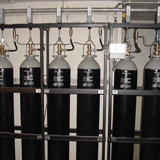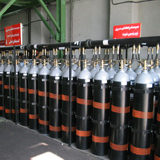Carbon Dioxide
Water is a tremendous fire suppression agent. It’s readily available, Inexpensive and environmentally clean. But sometimes water can damage equipment and is not a suitable extinguishing method for certain Locations. This is where gaseous fire suppression comes in. There are various types of gases, each with its own specific use. Twenty percent of the gaseous fire suppression market uses Carbon dioxide (CO2) based suppression. It’s effectiveness in putting out fires has long been known due to its versatility, cleanliness and its low costs when compared to other clean extinguishing agents.




Carbon dioxide is a colourless, odorless and electrically non-conductive gas that extinguishes fires by applying its relatively large density over the protected area. CO2 works by extinguishing fires in 2 separate mechanisms. Firstly; upon activation of the system, pressurized carbon dioxide is released in the protected area, causing a reduction in Oxygen concentration from 21 percent to fewer than 15, a level which fires cannot maintain combustion. The second mechanism acts by cooling the protected area and heat absorption which is a fundamental property of carbon dioxide.
CO2 Suppression systems are installed in two different ways.
- A) Local Application Uses a fixed supply of CO2 connected to a set of pipes that are arranged to discharge CO2 directly around the burning material in an area that is not enclosable.
- B) Total Flooding Using a calculated and fixed supply of carbon dioxide connected to a set of pipes with nozzles that are arranged to discharge CO2 upon activation into an enclosed space.
Advantages of Carbon Dioxide systems
- Zero residue
- Electrically non conductive
- Suitable for class A, B and C Hazards
- No Environmental Impact
- Carbon dioxide is an extremely dense compound, upon flare up of a fire hazard and operation of the system, it quickly covers up the hazard area and the fire is suppressed within Seconds.
 Germany Approved
Germany Approved
Typical Application
| Transformers | Switches | Circuit Breakers |
Electronic Equipment |
Gasoline and Liquid fuel-run engines |
| Paper | Wood | Generators | Plastics | Engine Rooms |
| Flammable Liquid Storage |
Textiles | Hazardous Solids |

